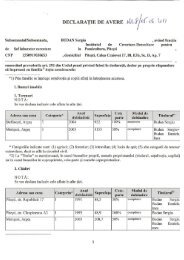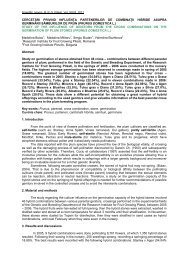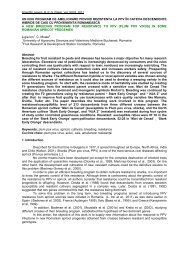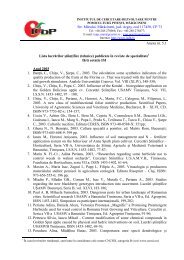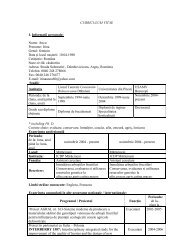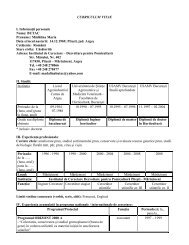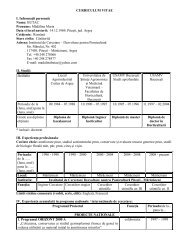46 prezent şi perspectivă în tehnologiile pomicole din românia în ...
46 prezent şi perspectivă în tehnologiile pomicole din românia în ...
46 prezent şi perspectivă în tehnologiile pomicole din românia în ...
You also want an ePaper? Increase the reach of your titles
YUMPU automatically turns print PDFs into web optimized ePapers that Google loves.
Scientific Papers of the R.I.F.G. Pitesti, Vol. XXV, 2009_________________________________________________<br />
3. Results and discussions<br />
Fruit growing systems evolution in Romania<br />
Stefan N. et al. (1993) referring to autochthonous high density orchards states that, although in the<br />
experiences carried out by the Romanian fruit growing research the performances were similar with the<br />
ones obtained abroad, ‘’the driving’’ under the production conditions of the technologies established by<br />
the research activity, was realized with different performances accor<strong>din</strong>g to the zones and production<br />
units.<br />
The same authors opiates that among the major factors determining the productive potential<br />
diminution of these plantations type were: the orchards setup on improper grounds, incorrect execution or<br />
lack of canopy forming works, abandon of the summer pruning, insufficiency of resources, poor technical<br />
equipment of the farms, inadequate organization, use of a non-specific assortment and frequent use of<br />
some to vigorous cultivars/rootstocks combinations which entered into productive period to late and lead<br />
finally to over crowded orchards.<br />
After 1990, due to the changes appeared by the application of the land property and administration<br />
laws (from Law 18/1991 up to Low. 247/2004), the fruit growing registered a significant regress,<br />
materialized by orchards surfaces diminution, fruit production reduction, also gradually decrease of the<br />
nurseries material stock and planting works.<br />
In the next images are presented some representative aspects of the apple orchards existing in<br />
Romania, established 25-30 years ago. Generally the MM 106 rootstock was used, in combination with<br />
many cultivars; the canopy shapes used, types ‘’palmete’’ with horizontal or oblique branches, determined<br />
the shadow persistence and poor differentiation of the fructiferous branches and buds in the inferior part<br />
of the tree canopies.<br />
The planting distances used were sometimes unbalanced with trees vigour (3.5 m – 3.6 m / 1.5 –<br />
2.0 m) and the trees high were limited at 2.0 m – 2.2 m by drastically and cost effectives annual pruning<br />
and periodic shorten of trees axes.<br />
Such kind of plantations had limited productive and economical performances, also because of<br />
the disequilibrium between the growth and yiel<strong>din</strong>g processes, generated by the necessity of more severe<br />
pruning (great consumers of high quality labour force), but also due the lack of irrigation water, supplied in<br />
required amounts at the right moment.<br />
In the latest years, in the same kind of plantations, sporadic was used the “spindle” type canopy<br />
(“slender spindle” and “spindle bush”), which offer the possibility of more efficient use of the production<br />
space, a better aeration and illumination of the fructiferous branches (figure 4) and offer a higher fruits<br />
production and quality, superior to the older plantations.<br />
In the experiences organized and carried out at ICDP Pitesti the differentiation between fruit<br />
growing systems was done taking into account the following indicators: ground use degree expressed by<br />
density (trees/ha) or by planting density, the biological material used (species and cultivar/rootstock<br />
combinations), trees grumping mode, canopy shape, the fructiferous wall height and thickness, orchard<br />
exploitation period, yield amount and quality on surface unit, all of them studied in dynamic, during the<br />
exploitation period, the investment value, the human labour force consumption, the production costs and<br />
the investment recovery period.<br />
Meteorological parameters evolution during the last 40 years and their influence on fruit growing<br />
By its geographical position, Romania is located in the temperate zone of the northern hemisphere,<br />
with a micro-thermal sub-humid climate in the greatest part of the territory and micro-thermal semiarid in<br />
the southern part: Baragan, Dobrogea, Southern Oltenia South-Eastern of Moldavia (Berbecel, 1983).<br />
The effects of the Global Climate Warming, the increased frequency of the dry years and not very<br />
uniform distribution of the precipitations during the vegetation period, lead to the accentuation of the semiaridity<br />
climatic character and its extent also in the hilly zones of the Romania. In this context, we shall<br />
present some tendencies of the climate in 1969-2009 periods, with consequences on the fruit growing<br />
activity.<br />
The polynomial curves of fifth degree trend allow us to affirm that in this period a clear tendency<br />
(statistically insured) was directed toward weather warming (figure 5). All determination coefficients for<br />
the regression curves are statistically insured, from 1996 to present, the phenomena probability rising up<br />
to 50%.<br />
The same tendency of values increase accor<strong>din</strong>g the time was evidenced also in the case of<br />
sunshine length period (figure 6, R 2 =0.2063**) and in the case of the annual medium rainfall deficit<br />
(R 2 =0.1534**), but for the precipitations, the general tendency was to decrease (R 2 =0.1076).<br />
As regard the intensity of correlation, between the monthly mean values of some meteorological<br />
parameters and some years included in the study (simples r, 1969-2009), the figure 8 reveal that among<br />
the year months that influence the trees entrance into vegetation, February was the month with the most<br />
significant changes; the higher temperature, day-night amplitude and sunshine length period, manifested<br />
a rise up tendency, which can determine in the future an earlier entrance into the vegetation of the fruit<br />
48




